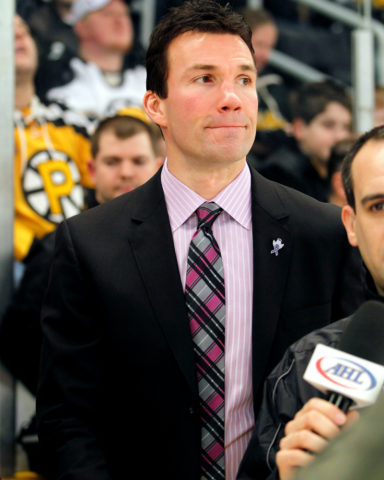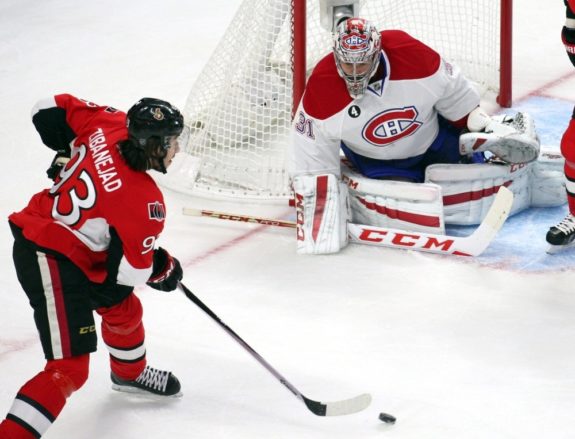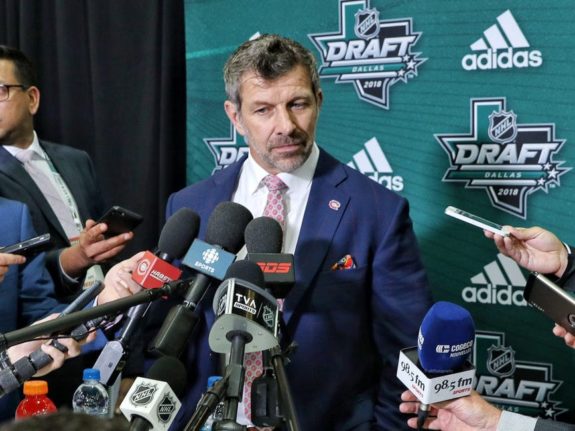The Canadiens are off to a strong start early on into the 2018-19 season. After impressive performances against two of the top teams in the Eastern Conference in the Toronto Maple Leafs and the Pittsburgh Penguins, the Habs are enjoying some early success, which has caught the fans and the experts by surprise.
The main reason why the Habs have been fascinating to watch early on has been the noticeable changes made when it comes to the style of game head coach Claude Julien wants his team to play. The Habs are playing a faster game, using their speed to attack and forecheck hard for loose pucks. Their transition game has improved considerably, moving the puck quickly out of the zone, and their defensive game is night and day from last season.
The influence from new assistant coaches Dominique Ducharme and Luke Richardson has been apparent in the systemic changes the Habs have made and the success we are noticing since the beginning of the season.
Defensive Zone Adjustments
When the Canadiens hired Richardson to replace J.J. Daignault, he was inheriting the 25th worst defensive squad from a season ago. Richardson was tasked with improving a defence core which remained intact with only the addition of Xavier Ouellet during the off-season.
What seemed like a daunting task for him to fix a defence without Shea Weber and David Schlemko to start the season, Richardson has been able to effectively use the weaknesses of his defencemen, and turn them into a strength.

Uploaded by Dolovis, CC BY 2.0, https://commons.wikimedia.org/w/index.php?curid=30880325)
The common theme from the previous season was that the Habs defence would either try to make a pass to their partner to move the puck out of the zone or if they were in trouble, use the glass or rim the puck around the boards. This would lead to a slower transition out of their zone and stall the attack, and on many occasions they would be hemmed in their end, hoping Price would freeze the puck.
One noteworthy change this season has been how active the blueliners have been to rush the puck out of their zone to join the forwards on the attack. Instead of using the boards as an outlet for the forwards to receive a pass from the defensive end, the defencemen is always in motion, either using the middle of the ice for a cleaner transitional pass or rushing the puck to the neutral zone.
These improvements have had a positive impact on the backend as they spend less time in their zone, which puts less of a burden on Price. Including the preseason, the Habs have allowed an average of 24 shots per game, which includes allowing only 26 shots versus the Maple Leafs, and 22 shots against the high-flying Penguins.
This defensive adjustment has also elevated Mike Reilly’s game to a level we haven’t seen since he was acquired at the trade deadline. He has benefitted from this new system as he’s able to skate with speed and confidence out of his zone, and he’s able to provide a solid first pass to his forwards, which fits right into how the Habs want to play this season.
Improved Penalty Kill
The penalty kill a season ago was a tire fire, to say the least. The Habs finished 30th in the NHL on the penalty kill, running at a 74.1 per cent efficiency. It was even worse on the road, where they averaged one of the worst percentages ever recorded since 1977, running at a 66.2 per cent efficiency.
The system deployed by Daigneault last season was passive. The defence seemed intent with giving up net-front presence, allowing other teams to generate high-danger chances. The PK did a horrible job cutting down the passing lane and having active sticks in the shooting lanes, and the goaltending was below-average, regardless of who was in nets.
Richardson, for his part, has implemented a system this season that seems to be more aggressive compared to Daigneault’s. The defenceman in this system plays more aggressively when it comes to attacking the puck-carrier coming in down low to force the other team to make an errant pass, that can be quickly picked off by the forwards. The forwards, for their part, have looked more active when it comes to blocking the shooting lanes, which has created a few opportunities to transition and create scoring chances going the other way.
It’s still very early in the season, but the Habs did a great job containing the Leafs and the Penguins, who both have lethal power plays, only allowing one goal on six opportunities on the road.

For the penalty kill to improve from their horrible showing last season, Price will have to be on top of his game to relieve the pressure off his teammates when they’re down a man. The adage has been that your goaltender has to be your best penalty killer if you want to have success, which wasn’t the case a season ago.
Speed, Speed, and More Speed
Since the start of training camp, Claude Julien kept saying that he wanted his team to play a faster game. He wanted to have a quicker transition game when it came to moving the puck out of their zone, always being in motion even without the puck, be aggressive in the neutral zone, and forecheck hard for loose pucks, which has been the case early on this season.
It’s been entertaining to see how fast the Habs are playing. In the first two games of the season, the Canadiens were all over their opponents when it came to five-on-five puck possession, something we were not accustomed to seeing last season.
What has been impressive has been their positioning on the ice. They seem to be in the right position when it comes to forcing turnovers in the neutral zone and keeping the pressure on their opponents when they don’t have the puck.
The Habs finally have the right personnel on the ice to play a fast game, which general manager Marc Bergevin has envisioned his team playing since he took over the reins six years ago. Even though they lost some goal scoring when they traded away Max Pacioretty and Alex Galchenyuk, those individual players do not fit the identity that this GM and coaching staff want to play.

The Habs finally have a style of play and identity that is noticeable and entertaining to watch. The question, however, remains: Is this a sustainable system to play with the players in place throughout the regular season? Only time will tell, but there is a sense of renewed optimism for the season, which is hard to believe considering where this organization was six months ago.